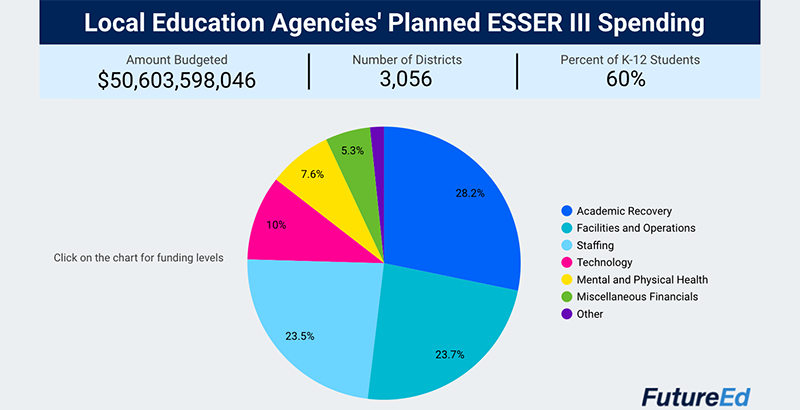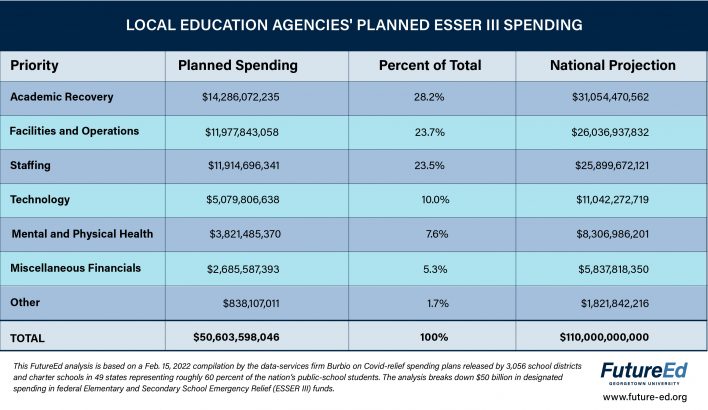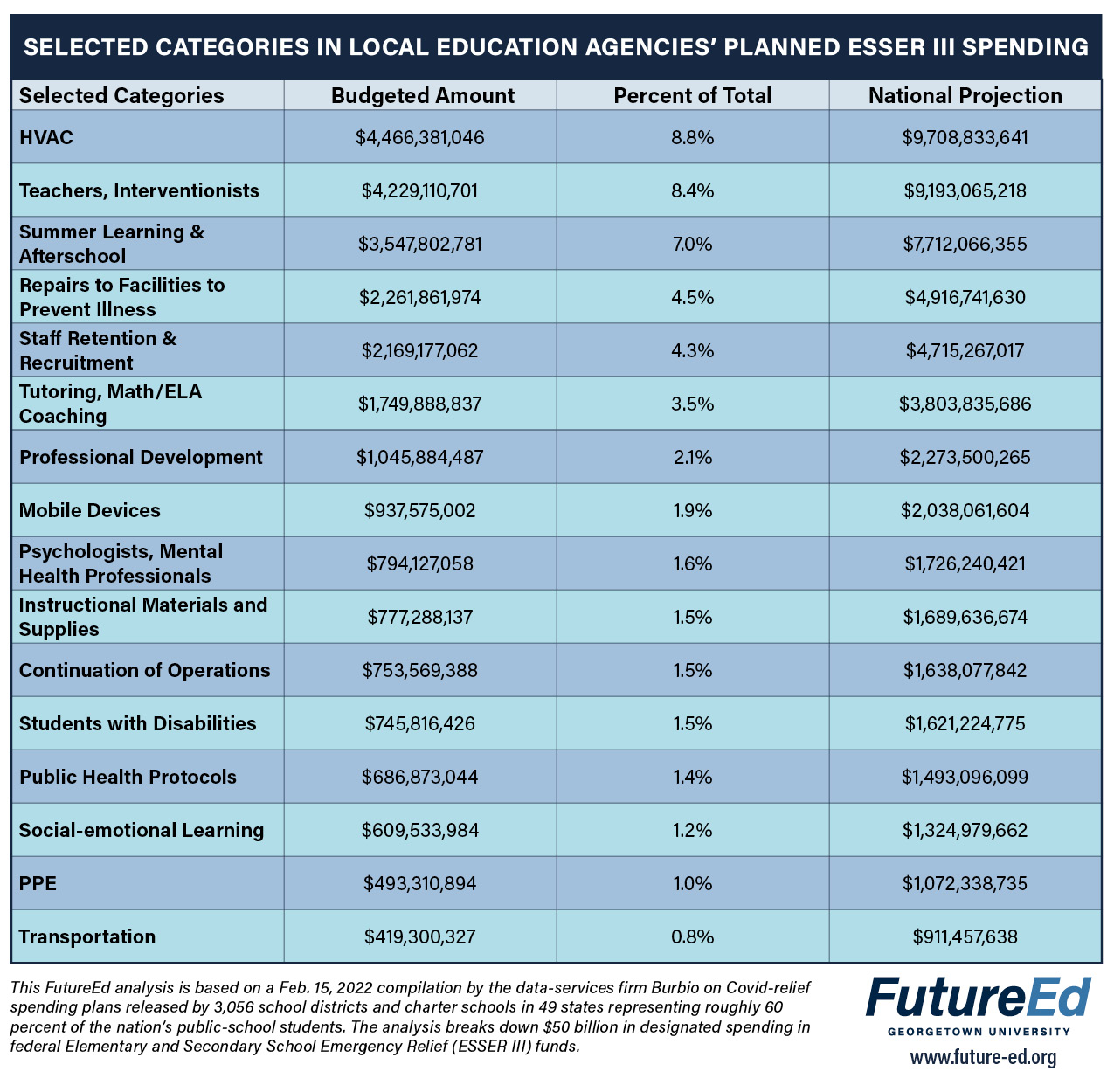Analysis: What Will $50B in COVID School Relief Funding Buy? How 3,000 Districts and Charters Nationwide Plan to Spend the Money

Get stories like these delivered straight to your inbox. Sign up for The 74 Newsletter
This analysis was published in partnership with FutureEd, an independent, nonpartisan think tank at Georgetown University’s McCourt School of Public Policy.
Nearly a year after Congress approved $122 billion in COVID relief aid for elementary and secondary education through the American Rescue Plan, school districts and charter organizations have targeted their spending on three priorities: academic recovery, staffing, and school facilities and operations, a new FutureEd analysis shows.
The analysis, the first to detail how relief money is flowing through local education agencies, examines spending plans from 3,056 school districts and charter organizations educating 60 percent of the nation’s public-school students. The plans, compiled by the data-services firm Burbio, show that local authorities have assigned dollar figures to about $50 billion of the $67 billion in federal Elementary and Secondary School Emergency Relief (ESSER III) funds they are due to receive. FutureEd examined the $50 billion in budgeted spending in seven major categories and 78 subcategories.
The spending trends suggest that localities could spend more than $31 billion in ESSER III funds on academic interventions, $25 billion on teachers and staff, and $26 billion on school facilities and operations by the 2024 deadline for spending the money.
Rural and suburban students are slightly underrepresented in the sample, and English learners and low-income students are slightly overrepresented. Fewer than 10 percent of the school districts in Wisconsin, Vermont, Alaska, Minnesota and Washington are included, and there are no districts or charter organizations from Montana and Rhode Island.
The Burbio sample nonetheless largely reflects the geographic and demographic diversity of the nation’s public school students, based on National Center for Education Statistics data, suggesting that the spending trends in the sample are nationally representative and can with some confidence predict how the nation’s education agencies are likely to spend ESSER III monies.

All districts and charter organizations were required to submit plans to state education agencies describing how the federal aid would be spent. About 500 districts included no dollar figures but detailed their priorities, largely accounting for why $17 billion of the $67 billion is not included in the analysis. Others provided overall amounts for major categories such as academic recovery or staffing; many more offered a detailed accounting of how they plan to spend their funds. Districts in Tennessee and a few elsewhere include spending from earlier ESSER funding rounds in their totals.
Local education agencies have earmarked the most resources for academic recovery, nearly $14.3 billion, or 28 percent, of the $50 billion captured in the Burbio sample. School districts and charters have a total of $110 billion to spend, with another $12 billion allotted to state education agencies.
Summer learning and afterschool programs make up nearly a quarter of academic recovery spending, about $3.5 billion in planned spending. That number could be expected to grow to $7.7 billion as districts plan for spending for the entire ESSER appropriation. Tutoring and coaching for math and English language skills comprise another 12 percent, or $1.7 billion, which could eventually reach $3.8 billion if trends hold true. Many districts set aside additional money for staffing these programs.
Instructional materials are also a priority, making up about 5 percent, or $777 million, and spending planned for students with disabilities is close behind, with $745 million. FutureEd found in a previous analysis that many under-resourced school districts are planning to use COVID relief funds to replace outdated instructional materials.
The scale of spending on academic interventions isn’t surprising, given the substantial learning deficits that emerged during the pandemic and that, in response, the American Rescue Plan requires local agencies to use at least 20 percent of their ESSER III allotment to address learning loss.
School districts and charter organizations have invested heavily in teachers and other staff to aid the academic recovery. Nearly $12 billion, or 24 percent, of the spending in the analysis will go toward staffing, with more than a third of that, or $4.2 billion, for the category that includes teachers, academic interventionists and guidance counselors. But given shortages of teachers and other staff in some parts of the county, some districts may struggle to hire the personnel they need.
About $2.2 billion, or 18 percent, of the planned staff spending will support teacher recruitment and retention efforts, and another $1 billion, or about 9 percent, is dedicated for professional development. Districts and charters are spending $794 million, or nearly 7 percent of the staffing total, on bringing additional psychologists and other mental health support into schools.
Facilities and operations are another major category, representing about a quarter of the planned spending in the $50 billion Burbio sample, nearly $12 billion. By far the largest priority in this category is upgrading heating, ventilation and air conditioning systems, with more than $4.4 billion earmarked for these projects, or about 37 percent of facilities and operations spending. If trends continue, the total for this category could reach $9.7 billion.

Another $2.3 billion, or 19 percent, is set aside for “repairs that prevent illness,” a priority that includes lead abatement, mold and mildew removal or replacement of leaking roofs. Other construction projects would add up to nearly $824 million. Operational priorities include plans for spending $493 million for personal protective equipment and $419 million on transportation.
As with instructional materials, we found that a large percentage of under-resourced school districts are investing in facilities projects, seemingly to compensate for years of deferred capital improvements.
Technology priorities, such as mobile devices and connectivity, account for $5.1 billion, or about 10 percent, of the $50 billion in our analysis; efforts to address students’ mental and physical health, such as social-emotional learning and public health protocols, add up to $3.9 billion, or nearly 8 percent of the total. A final $2.7 billion is committed to various financial needs, such as administering grants and keeping payroll and school operations going during the pandemic.
Bella DiMarco is a policy analyst for FutureEd. Prior to joining FutureEd, Bella worked at the Afterschool Alliance. Phyllis W. Jordan is associate director of FutureEd, an independent, nonpartisan think tank at Georgetown University’s McCourt School of Public Policy. She is the author of Attendance Playbook: Smart Solutions for Reducing Chronic Absenteeism, released by FutureEd and Attendance Works.
Get stories like these delivered straight to your inbox. Sign up for The 74 Newsletter

;)
